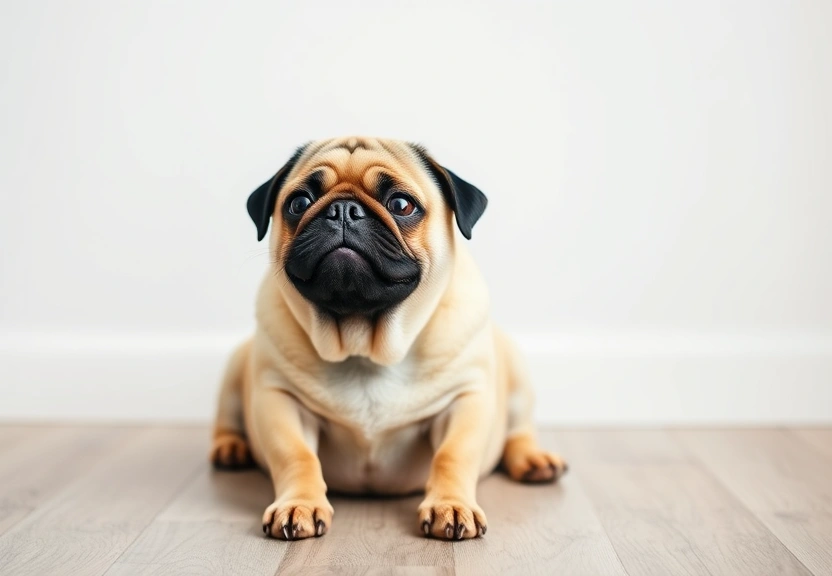Contents
Toggle7 Essential Insights You Must Know Before Welcoming a Pug into Your Life
Pugs are undeniably one of the most charming and lovable dog breeds out there. With their round, expressive eyes, squishy faces, and playful personalities, they have a unique charm that captures the hearts of many. However, while their adorable antics and affectionate nature make them irresistible companions, there are significant aspects to consider before inviting a pug into your home. Understanding the nuances of pug ownership can lead to a fulfilling relationship with your new furry friend.

This article aims to provide essential insights about living with pugs, focusing on their unique characteristics and the responsibilities that come with their care. Whether you are a first-time dog owner or an experienced pet parent, these insights will prepare you for what life with a pug entails.
1. Their Breathing Isn’t Just Cute Snoring
Pugs are classified as brachycephalic dogs, which means they have short muzzles that significantly affect their breathing. While their adorable snorts and snores can be endearing, these sounds are often indicative of breathing difficulties. Brachycephalic breeds like pugs are prone to a condition known as Brachycephalic Obstructive Airway Syndrome (BOAS), which can lead to serious health issues.
Understanding Brachycephalic Breathing
The shape of a pug’s face can lead to a narrow airway, making it challenging for them to breathe, especially during exercise or in hot weather. Here are some key points to consider:
- Exercise Caution: Pugs require regular exercise, but it’s crucial to monitor their breathing during physical activity. Short walks and gentle play are ideal.
- Heat Sensitivity: Pugs are especially vulnerable to heat exhaustion. Always provide a cool environment and avoid excessive outdoor activities in warm weather.
- Vet Visits: Regular veterinary check-ups are essential to ensure your pug’s respiratory health is being monitored and managed effectively.
🎥 Assista esta análise especializada sobre 7 Essential Insights You Must Know Before Welcoming a Pug into Your Life
2. Pugs Have Unique Temperaments
Pugs are known for their friendly and sociable personalities, but each pug has its own unique temperament. Understanding these traits can greatly enhance your relationship with your pug.
The Playful Comedian
Pugs are often described as the clowns of the dog world. They love to entertain their owners with their silly antics and playful behavior. However, this playful demeanor can sometimes lead to:
- Stubbornness: Pugs can be quite stubborn, so patience is necessary when training them. Consistent, positive reinforcement works best.
- Separation Anxiety: Pugs thrive on companionship and can suffer from separation anxiety if left alone for long periods. Consider your daily schedule before bringing a pug home.
3. Grooming and Maintenance Needs
While pugs have a short coat that requires minimal grooming, they do have specific grooming needs that should not be overlooked. Regular grooming is important for their physical health and overall well-being.
Skin Folds and Wrinkles
One of the most distinctive features of pugs is their adorable wrinkles. However, these skin folds can trap moisture and dirt, leading to potential infections if not cleaned regularly. Here’s how to manage their grooming:
- Regular Cleaning: Use a damp cloth to clean between their skin folds to prevent irritation and infection.
- Nail Trimming: Keep their nails trimmed to a comfortable length to avoid discomfort during walking.
- Bathing: Bathe your pug occasionally, but avoid over-bathing as it can strip their skin of essential oils.
4. Nutrition and Weight Management
Maintaining a healthy weight is crucial for pugs, as they are prone to obesity, which can exacerbate their breathing problems and lead to other health issues. Proper nutrition and portion control are vital components of their care.
Feeding Guidelines
When it comes to feeding your pug, consider the following:
- Quality Dog Food: Choose a high-quality dog food that meets their nutritional needs. Consult your veterinarian for recommendations.
- Controlled Portions: Be mindful of portion sizes to prevent overeating. Follow feeding guidelines based on their age, weight, and activity level.
- Treats in Moderation: While it’s tempting to spoil your pug with treats, moderation is key. Opt for healthy treats and limit their intake.
5. Health Issues to Watch For
Pugs are generally healthy dogs, but they do have specific health issues to be aware of. Being proactive in managing their health can lead to a longer, happier life.
Common Health Concerns
Some health issues pugs face include:
- Eye Problems: Due to their prominent eyes, pugs are susceptible to various eye conditions, such as corneal ulcers and cataracts.
- Hip Dysplasia: This genetic condition can cause pain and mobility issues. Regular vet visits can help monitor and manage this.
- Skin Conditions: Pugs can develop skin allergies or infections, especially in their folds. Regular grooming and cleaning can help prevent these issues.
6. Training and Socialization
Training and socialization are essential aspects of raising a well-adjusted pug. Early training helps prevent behavioral issues and ensures your pug is a well-behaved member of your family.
Effective Training Techniques
When training your pug, consider the following techniques:
- Positive Reinforcement: Use treats and praise to reward good behavior. This will make training more enjoyable for your pug.
- Consistency is Key: Be consistent with commands and rules to avoid confusing your dog.
- Socialization Opportunities: Expose your pug to various environments, people, and other dogs to help them develop confidence and reduce anxiety.
7. The Joys of Pug Ownership
Despite the responsibilities that come with owning a pug, the joys they bring to your life are immeasurable. Pugs are loving, loyal companions who thrive on human interaction.
Building a Bond
Building a strong bond with your pug involves:
- Quality Time: Spend quality time with your pug through play, cuddles, and training sessions.
- Understanding Their Needs: Pay attention to your pug’s needs and preferences, ensuring they feel secure and loved.
- Creating a Routine: Establishing a daily routine helps your pug feel more at ease and secure in their environment.
Frequently Asked Questions
1. Are pugs good for first-time dog owners?
Yes, pugs can be great for first-time dog owners due to their affectionate nature and adaptability. However, it’s essential to be prepared for their unique needs.
2. How much exercise do pugs need?
Pugs require moderate exercise, about 30 minutes a day, split into shorter walks and play sessions to prevent breathing difficulties.
3. Do pugs shed a lot?
Pugs shed moderately. Regular brushing can help manage shedding and keep their coat healthy.
4. Can pugs live in apartments?
Yes, pugs are well-suited for apartment living due to their small size and low exercise requirements, but they still need regular outdoor time.
5. What is the average lifespan of a pug?
The average lifespan of a pug is around 12 to 15 years, though proper care can help extend their life.
Conclusion
Welcoming a pug into your life can be a rewarding experience filled with love, laughter, and companionship. However, understanding the unique challenges and responsibilities that come with pug ownership is crucial. From their brachycephalic breathing issues to their playful personalities, pugs require thoughtful consideration and commitment. By being informed and prepared, you can create a nurturing environment for your pug, leading to a joyful and loving bond that lasts a lifetime. If you’re ready to embrace the quirks and joys of living with a pug, you will undoubtedly find an unforgettable companion in your furry friend.
📰 Original Source
Este artigo foi baseado em informações de: https://iheartdogs.com/thinking-about-a-pug-7-things-to-know-before-you-commit/?utm_source=rss&utm_medium=rss&utm_campaign=thinking-about-a-pug-7-things-to-know-before-you-commit





